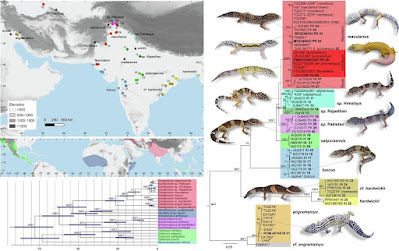 |
in Agarwal, Bauer, Gamble, Giri, Jablonski, et al., 2022. |
Highlights
• First multi-locus, range-wide sampling of leopard geckos, including most recognised species, synonyms.
• Updated time-tree for Eublepharidae shows most recent common ancestry at 77 Myr ago.
• 10 species of Eublepharis, Oligo-Miocene origins, with the most recent common ancestor entering India from Saharo-Arabia.
• Pleistocene separation of lineages occurs across different biogeographic regions within E. angramainyu and E. hardwickii, with E. macularius now recognized as five species .
• Model organism E. macularius represents a single population of this species with low mtDNA divergence, distributed in Pakistan.
Abstract
The leopard gecko, Eublepharis macularius, is a widely used model organism in laboratory and experimental studies. The high phenotypic diversity in the pet trade, the fact that the provenance of different breeding lines is unknown, and that distinct Eublepharis species are known to hybridize, implies that the continued use of E. macularius as a model requires clarity on the origin of the lineages in the pet trade. We combine multi-locus sequence data and the first range-wide sampling of the genus Eublepharis to reconstruct the evolutionary history of the Eublepharidae and Eublepharis, with an updated time-tree for the Eublepharidae. Our sampling includes five of the six recognized species and additional nominal taxa of uncertain status comprising 43 samples from 34 localities plus 48 pet-trade samples. The Eublepharidae began diversifying in the Cretaceous. Eublepharis split from its sister genera in Africa in the Palaeocene-Eocene, and began diversifying in the Oligocene-Miocene, with late Miocene-Pliocene cladogenesis giving rise to extant species. The current species diversity within this group is moderately underestimated. Our species delimitation suggests 10 species with four potentially unnamed divergent lineages in Iran, India and Pakistan. All 30 individuals of E. macularius that we sampled from the pet trade, which include diverse morphotypes, come from a few shallow E. macularius clades, confirming that lab and pet trade strains are part of a single taxon. One of the wild-caught haplotypes of E. macularius, from near Karachi, Pakistan, is identical to (10) pet-trade samples and all other captive populations are closely related to wild-caught animals from central/southern Pakistan (0.1–0.5 % minimum pairwise uncorrected ND2 sequence divergence).
Keywords: Aridification, Divergence dating, Eublepharis macularius, Historical biogeography, Pet trade
Ishan Agarwal, Aaron M. Bauer, Tony Gamble, Varad B. Giri, Daniel Jablonski, Akshay Khandekar, Pratyush P. Mohapatra, Rafaqat Masroor, Anurag Mishra and Uma Ramakrishnan. 2022. The Evolutionary History of An Accidental Model Organism, the Leopard Gecko Eublepharis macularius (Squamata: Eublepharidae). Molecular Phylogenetics and Evolution. 168; 107414. DOI: 10.1016/j.ympev.2022.107414
